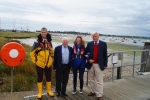
Chichester MP has signed her name to the Blue Belt Charter. With the fifth largest marine estate in the world, the UK and its Overseas Territories are custodian to the largest coral atoll on earth, globally significant populations of albatross, whales and turtles, and as many as a quarter of the penguins on the planet.
Through the actions of successive governments, the UK has demonstrated global leadership in ocean conservation. The Charter calls on the UK to reaffirm this leadership by working with the governments of the Overseas Territories to deliver on Blue Belt pledges to:
-
Establish a 500,000 km² fully protected Marine Protected Area around the South Sandwich Islands in 2018
-
Deliver on the commitment to establish a fully protected Marine Protected Area in at least 50% of Ascension Island’s waters in 2019
-
Support the establishment of a locally-led marine protection regime throughout the waters of Tristan da Cunha by 2020
-
Strengthen the development of the locally-led marine protection regime throughout the waters of St Helena
We also call on the UK to remain a leading force within those international bodies concerned with greater protection of the Polar Regions, the UN process for establishing Marine Protected Areas on the High Seas, and within the Regional Fisheries Management Organisations.
What is the Blue Belt Charter?
As the challenges facing our oceans increase, public interest in marine conservation is at an all-time high. More than 12 million people in the UK viewed the first episode of Sir David Attenborough’s Blue Planet II, with an estimated 500 million globally expected eventually to see the series.
The UK’s Blue Belt policy to increase marine protection throughout the UK Overseas Territories (UKOTs) can drive greater international cooperation on ocean conservation and is a fantastic example of British leadership in world conservation. While the Blue Belt enjoys cross-party support, upcoming decisions risk suffering from a lack of ambition without an injection of greater political urgency.
The Great British Oceans coalition of RSPB, Greenpeace UK, Zoological Society of London, Pew Trusts, Blue Marine Foundation and the Marine Conservation Society is calling on parliamentarians to sign the Blue Belt Charter to show their support for the UK’s global leadership in protecting the ocean.1
What is the “Blue Belt”?
The “Blue Belt” is the UK Government’s policy to establish globally significant marine reserves in a number of the UK Overseas Territories. The policy was supported in the Conservative, Labour and Liberal Democrat manifestos in both the 2015 and 2017 elections.
The Blue Belt Charter seeks parliamentary support for strong implementation by 2020 of four massive Blue Belt opportunities around the South Sandwich Islands2, Ascension Island3 and Tristan da Cunha4 and St Helena5. Collectively these sites would place two million sq km of ocean under protection, an area more than six times the size of the United Kingdom. Ambitious implementation of the Blue Belt will also enhance the UK’s capacity to lead on ocean conservation within a range of international institutions.
Why must the UK continue to lead on ocean protection?
The ocean is crucial to all life on the planet, providing 50% of the oxygen we breathe, the primary source of protein for billions of people and a shield from the more extreme impacts of climate change. But the oceans are under threat – they are filling with plastics, warming and acidifying due to carbon emissions, and 90% of global fish stocks are now considered overfished or fully exploited. Depleted ecosystems are less resilient to change and less able to provide the critical functions on which humans depend. The UK is responsible for the 5th largest marine estate in the world, principally through the 14 Overseas Territories which host some of the most outstanding marine biodiversity on earth.
Highly protected marine reserves have been acknowledged as a critical tool in helping arrest the declining health of our oceans. Governments have committed to a global target of protecting at least 10% of our oceans by 2020, but the world is approximately only half way towards reaching this target. Decisive action is needed and the UK is in a privileged position to make a significant contribution. Momentum is also building at the UN for a treaty to protect areas of ocean beyond national jurisdiction, known as the high seas. A successful Blue Belt programme can inspire more ambition from Britain’s international partners to accelerate their own efforts in ocean protection.
How is the Blue Belt currently being implemented?
The Foreign Office is clear that the Blue Belt must be achieved in collaboration with the territories. “Track One” territories (British Antarctic Territory; Pitcairn Islands; Ascension; Tristan da Cunha; St Helena, British Indian Ocean Territory and South Georgia and South Sandwich Islands) are those that have already established, or stated an intention to establish, large Marine Protected Areas. This welcome leadership from these territories must be supported by the UK Government, including maintaining at least the £4.8 million of funding per year committed to by the previous Government through to the end of this Parliament in 2022. The remaining “Track Two” UKOTs will consult further with the UK Government before policy recommendations are brought forward
In the South Sandwich Islands, Ascension, Tristan da Cunha and St Helena, an opportunity exists to safeguard marine biodiversity of unparalleled global value spanning the Southern Ocean to the tropical reaches of the Atlantic. If delivered upon, in combination with existing reserves in the Indian Ocean (British Indian Ocean Territory) and the Pacific (Pitcairn Islands), these Blue Belt commitments would make the UK the only state in the world to establish large highly protected marine reserves in each of the Indian, Pacific, Atlantic and Southern Oceans.


